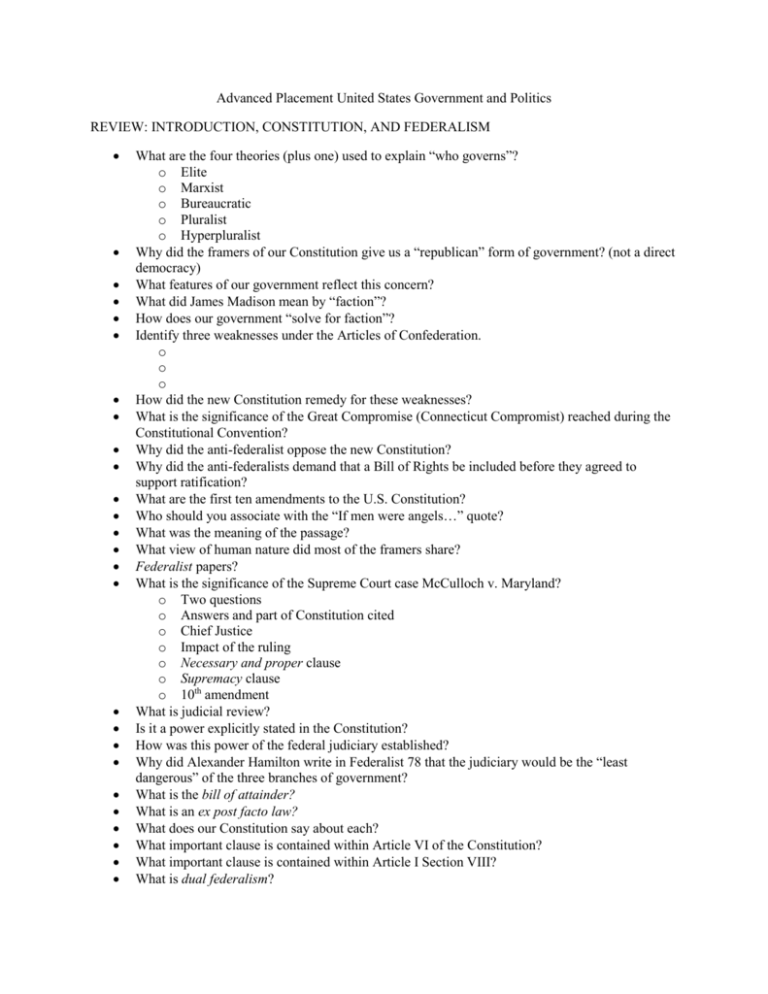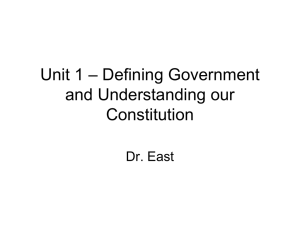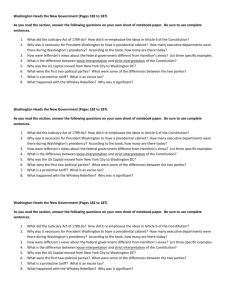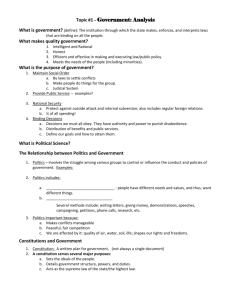Advanced Placement United States Government and Politics
advertisement

Advanced Placement United States Government and Politics REVIEW: INTRODUCTION, CONSTITUTION, AND FEDERALISM What are the four theories (plus one) used to explain “who governs”? o Elite o Marxist o Bureaucratic o Pluralist o Hyperpluralist Why did the framers of our Constitution give us a “republican” form of government? (not a direct democracy) What features of our government reflect this concern? What did James Madison mean by “faction”? How does our government “solve for faction”? Identify three weaknesses under the Articles of Confederation. o o o How did the new Constitution remedy for these weaknesses? What is the significance of the Great Compromise (Connecticut Compromist) reached during the Constitutional Convention? Why did the anti-federalist oppose the new Constitution? Why did the anti-federalists demand that a Bill of Rights be included before they agreed to support ratification? What are the first ten amendments to the U.S. Constitution? Who should you associate with the “If men were angels…” quote? What was the meaning of the passage? What view of human nature did most of the framers share? Federalist papers? What is the significance of the Supreme Court case McCulloch v. Maryland? o Two questions o Answers and part of Constitution cited o Chief Justice o Impact of the ruling o Necessary and proper clause o Supremacy clause o 10th amendment What is judicial review? Is it a power explicitly stated in the Constitution? How was this power of the federal judiciary established? Why did Alexander Hamilton write in Federalist 78 that the judiciary would be the “least dangerous” of the three branches of government? What is the bill of attainder? What is an ex post facto law? What does our Constitution say about each? What important clause is contained within Article VI of the Constitution? What important clause is contained within Article I Section VIII? What is dual federalism? What is a federal grant-in-aid? What is a categorical grant? What is a block grant? Which has grown more rapidly in recent years? Explain. Which do liberals prefer? Which do conservatives prefer? Explain What is “devolution”? (devolution revolution) How has the growth in federal grants-in-aid impacted federal-state relation? (the state of our federal system?) Why if conservatives favor devolution and block grants, have categorical grants grown more quickly? What are some merits and demerits of federalism? Advanced Placement U.S. Government and Politics REVIEW: POLITICAL CULTURE, PUBLIC OPINION, POLITICAL PARTICIPATIONAND INFORMAL INSTITUTIONS (POLITICAL PARTIES, ELECTIONS AND CAMPAIGNS, INTEREST GROUPS, MEDIA) What is valued in American political culture? Demographics and ideology? (gender, race, schooling region, socio-economic status, religion) What is meant by political socialization? Demographics and participation? (age, race, schooling, region, socio-economic status, religion) What is the most common form of political activity in the United States? How does voter turnout in the U.S. compare to other democracies? Why is turnout in the U.S. lower than most other democracies? What percentage of Congressional incumbents get reelected in the modern era? Advantages of incumbency (Congressional)? Sources of campaign funds (Congress)? What is the franking privilege? Reapportionment (what is it? Who does it?) Redistricting? Gerrymandering, malapportionment Who redraws Congressional district lines? What is the electoral college?...winner-take-all and plurality? …# of electoral votes per state?...what it takes to win the Presidency? Why a two-party system? What is a realignment (critical election)? How many have occurred in U.s. history? When was the last realignment? What is a dealignment? Did the South realign in the 1980s? Trends about Parties, apathy , mistrust of government, voter turnout Coalition of support for the Democratic Party? What is the coattail effect? Does it exist today? What percentage of Congressional incumbents are re-elected? Which races are most competitive? (House, Senate, Presidency) What decides national elections (Presidency)? (party ID, issues, state of economy, war) What is the difference between retrospective voting and prospective voting? What is the difference between an open, closed, and blanket primary? Significance of choosing V.P. running mate? What is a PAC?...when created?...why?...constraints?...problems? Effect of Presidential primaries on American government and politics? (parties, Convention, length of campaigns, cost of campaign, frontloading, campaign strategies) Primary election strategy v. general election strategy? (Presidential races) Who does the American public directly elect? (federal government) What is a linkage institution? Which races is there public financing (federal funds) of? (Presidency, House, Senate, Gubernatorial) What is the significance of the following amendments? o 15th o 17th o 19th o 23rd o 24th o 26th How are political parties organized in the U.S.? (decentralized v. centralized) Why have political parties grown weaker? What evidence indicates that political parties in the U.S. have grown weaker? Two-party system – why? Role of third parties? National Party Structures Realignment (critical election) Dealignment Evidence that parties are weaker Are parties resurgent? Why has voter turnout declined since 1060? Changes in Presidential nominating process o primaries and caucuses o national conventions o campaign length/cost o media coverage o Convention delegates o Superdelegates Campaign Finance Rules (1974, 2002, Citizens United ruling 2010) Public Financing of Campaigns Interest Groups and PACs – trend Super PACs (independent expenditures) Interest groups influencing policy (lobbying, campaign contributions, grassroots campaign, litigation) Media o gatekeeper, scorekeeper, watchdog (adversarial press) o coverage of candidates, campaign use of media o visuals and spots Advanced Placement U.S. Government and Politics REVIEW: FORMAL INSTITUTIONS (Congress, Presidency, Bureaucracy, and Judiciary) CONGRESS qyualification (House/Senate) Term (House/Senate) Size Enumerated powers “necessary and proper” clause Bicameral legislature Filibuster Cloture Rules committee in House Discharge petition Ways and Means, Appropriations – House Leadership positions Committees (Standing, Select, Joint, Conference) Chairs/Assignments Incumbency advantage Marginal district Safe district Gerrymandering Malapportionment Reapportionment – trend Simple resolution, concurrent resolution, joint resolution Port-barrel legislation, logrolling Party polarization Franking privilege Divided government PRESIDENCY Constitutional qualifications/term Enumerated powers (alone and shared) Expansion of powers (how?) Divided government Unified government Office of the White House o White House Office (West Wing) o Executive Offices of President o Cabinet Appointments/considerations Executive privilege Impoundment Legislative role Types of veto o Regular veto (veto message) o Pocket veto o Line-item veto (Constitutional) Why vetoes have “teeth”? Why Presidents don’t go “veto crazy”? Running for President/campaign financing Impeachment Presidential transition “honeymoon period” Lameduck Presidential popularity JUDICIARY Appointed by President Confirmed by… For life (tenure) “above politics” Supreme Court – justices? Caseload – original jurisdiction v. appellate jurisdiction Writ of cert Judicial restraint v. judicial activism Original intent v. contemporary meaning Earl Warren William Rehnquist “amicus curaie” brief Judicial review Lower courts (and jurisdiction) determined by Congress Appellate jurisdiction and size of Supreme Court determined by Congress “stare decisis” – precedent BUREAUCRACY Growth of bureaucracy 4th branch of government Discretionary authority Iron triangle – “capture agencies” – “client politics” “Issue networks” Congressional oversight (3 “A”s and “I”) Advanced Placement U.S. Government and Politics REVIEW: CIVIL LIBERTIES AND CIVIL RIGHTS CIVIL LIBERTIES o Selective Incorporation o 14th Amendment o Landmark cases o 1st amendment o Clauses pertaining to “free expression” (4) o Clauses pertaining to “religion” (“establishment” clause and “free-exercise” clause) o 4th, 5th, and 6th amendments o Exclusionary rule CIVIL RIGHTS o 14TH AMENDMENT o 15TH AMENDMENT o Plessy v. Ferguson o Brown case o Civil Rights Act 1964 o Voting Rights Act 1965 o Americans with Disabilities Act LANDMARK COURT CASES o Marbury v. Madison o McCulloch v. Maryland o Schenck v. U.S. o Gitlow v. N.Y. o Roe v. Wade o Griswald v. Connecticut o Bakke case (affirmative action case) o Grutter case (Michigan affirmative action ruling) o Citizens United case o Mapp v. Ohio o Miranda v. Arizona o Gideon v. Wainright o N.J. v. T.L.O. o Engel v. Vitale o Lemon v. Kurtzman o Reynolds v. U.S. o Oregon v. Smith o Texas v. Johnson o Tinker v. Des Moines, Iowa o Brown v. Topeka Board of Education TERRORISM AND CIVIL LIBERTIES o September 11th, 2001 o PATRIOT Act o Designed to increase Federal powers to investigate terrorist o PROVISIONS o Telephone taps o Internet taps o Voice mail o Grand jury information Immigration detentions Money laundering eliminates statute of limitations on terrorist crimes and increases penalties o ***typically the Supreme Court has granted exceptional powers to the federal government during wartime AMENDMENTS o Amending process o 1st, 4th, 5th, 6th, 8th, 9th, 10th o 14th (due process, equal protection) o Voting amendments – 15th, 17th 19th 23rd,24th,26th MORE REVIEW o War Powers Act (1973) o Budget and Impoundment Act (1973) o Patriot Act (2001) o Civil Rights Act (1964) o Voting Rights Act (1965) o Clean Air Act (1960s- several) o Environmental Protection Act (1970) o Campaign Finance Reform Act (1974,2002) o Americans with Disabilities Act (1990) o Family Leave Act (1993) o Welfare Reform Act (1996) o o Advanced Placement U.S. Government and Politics ESSAY GUESS-TIMATES INTERCONNECTING THEMES o Constitutional underpinnings, federalism o Informal institutions o Formal institutions o Civil liberties/Civil rights/public policy CONGRESS o Divided government and gridlock o Polarization o Incumbency advantage o Oversight of bureaucracy o Appointment process (non-appointment process) o Foreign policy o Fiscal federalism o Rules/procedures impacting legislative process o Reining in Presidency (War Powers Act, Budget and Impoundment Act) PRESIDENCY o Expanding executive power beyond what is Constitutionally stated (Imperial presidency, foreign policy, War on Terror, Patriot Act) o Threat to separation of powers o Bully pulpit/use of media o Use of executive orders and executive agreements o Divided government o Saying “No” – Veto, Impoundment, Executive privilege JUDICIARY o Appointment process o Litmus test o Judicial activism v. judicial restraint o “above politics” o But not completely “above politics” BUREAUCRACY o Growth o Discretionary authority o “Iron triangle” or “client politics” o Issue networks o Congressional oversight ELECTIONS AND CAMPAIGNS o Role of Presidential primaries and National Conventions o Influence of 3rd parties o Electoral college o Media role o Voting methods, federalism, reform (2000 election) o Campaign Finance Reform o Interest groups/PACs POLITICAL PARTIES o Resurgent or in decline PARTICIPATION AND DEMOGRAPHICS PARTY ID/IDEOLOGY AND DEMOGRAPHICS CIVIL RIGHTS AND AFFIRMATIVE ACTION o Bakke case o Michigan case (Grutter) BUDGETARY PROCESS o KEY PLAYERS (Pres., OMB, Congress, Key Committees, CBO) o Politics of Budgetary process o Democrats v. Republicans (polarization) o Divided government o What Americans want is inconsistent? o Pork barrel (earmarks)/ logrolling o What to cut? (entitlements?, defense spending?, interest payments on debt) o Raise taxes? (good luck with that) o Mounting budget deficits and national debt CIVIL LIBERTIES/CIVIL RIGHTS LANDMARK CASES








